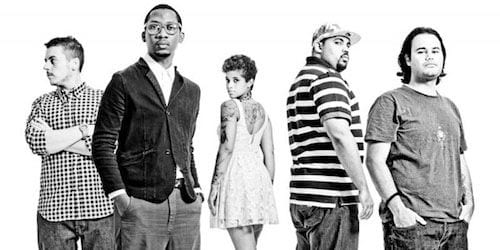
Spare. Dark. Relentless. On Komba, the second album from Portuguese dance collective Buraka Som Sistema, fierce club beats propel everything forward like time’s ever-rolling stream bears us all away. Buraka don’t do pretty melodies, sweeping synth riffs or major keys. They don’t do much in the way of lyrics, and they make no overt concessions to human emotions, except those concerned with kinetic body motion. The album cover is a grinning skull floating over a sea of black — you don’t go into it expecting Deadmau5.
Look closer at that skull, a painting by the Brazilian artist Calma, and the cover becomes a little more reassuring. The skull exhibits evidence of humanity: a sinking ship, a pipe, a key with a little cross carved into it, a decapitated chicken. Things are looking up! And once you move past the nonstop rawness of Buraka’s songs, you’ll find ample evidence of life-affirming humanity embedded in their music. They lavish their beats with attention. Much like Calma’s cover skull, which recalls the extravagant decorations marking a Day of the Dead celebration, Komba bursts with evidence that Buraka spent a loooong time constructing these tunes. Like a lot of dance music, the basic patterns and textures repeat in four-bar cycles, but any random four-bar sequence contains some unexpected element — a little ripple before the beats, a simple synth hook that never reappears — that renders its song exquisite.
Which is to say, I haven’t actually danced to Komba, and while I don’t discourage the practice, the music enhances other kinetic body motions as well. (I’m partial to rocking in a rocking chair.) Komba’s beats reward close listening. Buraka draw their beats from the “hard-ass” feel of the recent club craze kuduro, Angola’s answer to Brazil’s favela funk music. (Conductor, one of the group’s three founding producers, hails from the West African country.) Much of Komba sounds like music you’d hear from M.I.A., the jet-setting kuduro fan and onetime Buraka guest-vocalist. Even within that consistent style, Buraka’s beats vary from the handclap gallop of “Candonga” to a cool not-quite three-against-four stagger in “Vem Curtir”. The beats break down frequently, but they never lose momentum — some other element always swoops in to pick up the slack. The rapid-fire bubble sounds of “Tira O Pe” are especially charming.
Charming vocals, too, whether it’s the dude who proclaims, “I’m like, I’mI’m like, I’m like hypnotized” — you’ll know the feeling — or Buraka vocalist Blaya and her gal pal Roses Gabor, who celebrate booty calls and girls’ nights out in “(We Stay) Up All Night”. The album reportedly explores the concept of celebrating in the face of death — a “komba” is a week-long Angolan wake — but only the one-two punch of “Eskeleto” and the title song state that theme explicitly in English. The rest focus on the celebration or, in “Hangover (Bababa)”, the celebration’s after effects. Kuduro musicians also enjoy using vocals as percussion elements, and Buraka have a blast with all their little “bababa”s and voices burbling up around the main melodies. In the song “Komba”, when guest-rapper Kaysha ziggy-zang-azang-azangzangs along with the swinging, seemingly live snare drum pattern, Buraka achieve a sound that’s almost like Bo Diddley playing jazz after huffing some laughing gas. You know you wanna hear that.
If you stretch it far enough, even “Up All Night” fits the theme of mourning into dancing. When do you stay up all night? Unless you’re working the graveyard shift, it’s usually under extraordinary and wired circumstances, whether celebratory or otherwise. Whether you’re partying or getting too many phone calls of love and condolence from friends and relatives, the details become as clear and unforgettable as a decorated skull in your mind. At their best, mourning and dancing demand all our attention — a fact that Buraka Som Sistema realize, embrace and set to some hard-ass beats.

![Call for Papers: All Things Reconsidered [MUSIC] May-August 2024](https://www.popmatters.com/wp-content/uploads/2024/04/all-things-reconsidered-call-music-may-2024-720x380.jpg)



